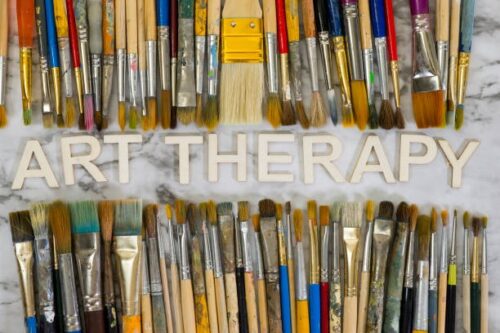These days, most of the news is quite dreary and depressing. With that, one of the few easily available breaks is creating art. The fact that we can create art, beautiful things, and meaningfully beautiful things is, at the very least, a glimmer of hope in these times of global despair. In order to support the therapeutic process, art therapy combines creative and verbal or nonverbal strategies. It is a clinical, diagnostic, and therapeutic tool.

What Is Art Therapy?
Art therapy provides a means of diagnosing and treating patients by exploring the realm of artistic representation and symbolism. Art therapy is a highly advantageous approach to helping children manage chronic illnesses since it has been demonstrated to effectively alleviate the emotional strain of being in a medical facility. Art is a common way for kids to communicate and let go of their stress and worry.
Children who are suffering from illnesses often find that their art validates their difficult feelings and experiences. Kids are able to create a barrier between themselves and their healthcare issues by painting about their medical condition, trauma, or treatments. They frequently learn that their difficulties are not a part of who they are, as well as that they possess an identity apart from their disease by processing their problems through citation of art.
Resources regarding how their identity affects professional interactions and relationships with clients have yet to be made available to Jewish art therapists. This examines the ways that prejudice and unresearched Jewish misunderstanding affect the field (Judaism). Negotiating the client’s views, downplaying Jewish hardship, misinterpreting Israel complaints, and integrating Jewish and White identity are a few of them. Art therapists can combat these influences through advocacy, education, and introspection.
Regardless of the level of quality of the finished piece, the artistic process serves as a medium for:
Introspection And Expressing Oneself
Increasing Self-Worth
Organizing And Managing Challenging Emotions And Situations
Gaining A Feeling Of Achievement
Speaking With Other People
Using Symbolic Language To Communicate Unspoken Emotions And Thoughts That Are Unlikely To Be Expressed.
About Art Therapy
Screaming, crying, and confessing are all part of the creative process. However, the presentation of art therapy is just different. Your emotions are being transformed into something lovely that you create. Crafting art out of your emotions is a clear description of the hiddur mitzvah. It is self-expression, and confession is mitzvohs. It involves transforming a commandment into one that is exquisite. Drawings are our minds and brains translating into the language of images—confessions, admissions, shouts, tears, and discussions. Are you familiar with the proverb, “A picture is worth a thousand words”? This is no jest. All art is a different dialect of our own language.
Professional psychotherapists are known as art therapists with specialized training in incorporating art mediums, art processes, and transferring art products into therapeutic interventions. Professionals in art therapy have expertise in using various mediums such as paint, clay, sketching, and drawing. Each art therapist specializes in a different area and can send and work with families, couples, groups, or individuals. It is essential to read between the benefits of the treatment.

Benefits Of Art Therapy
Remember, more study is required because most of the studies that have been done so far have tiny populations, which makes it challenging to draw generalizations for bigger groups. Having said that, here are some potential advantages for health and well-being that the new and developing area of art therapy may offer:
May Reduce Stress
Making art may offer essential stress management from life’s brutal assault when combined with treatment. Beyond just preventing and reducing stress, art therapy also improves one’s psychological, emotional, and physical health, as well as one’s quality of life. Research on the effects of art and engaged imaginative thought on the brain reveals that individuals with new creative outlets frequently have higher dopamine levels. A neurotransmitter called dopamine is frequently deficient in those who suffer from anxiety, depression, or extreme stress.
Art therapy allows people to express themselves with greater freedom, take better care of their psychological well-being, and build stronger bonds with others. Art therapy is predicated on the notion that creative expression can aid healing and improve one’s mood. Making art may be a catharsis for challenging emotions, a diversion from worrying ideas and situations, and an opportunity to enter an emotional state of “flow” that has numerous healing benefits. It also results in a stunning work of art at the end.
May Build Self-Esteem And Boost Self-Image
Even while the majority of recent research on art therapy focuses on chronic medical conditions, the method may also aid in fostering self-expression and a sense of autonomy, independent thinking, and sustainable development in healthy individuals.
People who use art therapy can have a better understanding of who they are, how they feel, and how they behave. By enabling people to discover and value their special talents and abilities, it can also aid in the development of self-worth and self-esteem.
When it comes to accepting and loving oneself for who you are, artistic expression may be a source of positive affirmation. This is particularly true for those who are dealing with poor self-esteem or a negative view of their bodies. Art therapy is predicated on the notion that artistic expression can aid in healing and improve one’s mood. Furthermore, studies have shown that art therapy interventions can improve the mental, emotional, and physical growth of individuals with cancer, physical disabilities, and chronic illnesses in both children and adults.
May Help People With PTSD
It can be very challenging to relive trauma, especially if PTSD symptoms include nightmares and flashbacks. Without going through past experiences, art therapy can assist people in discovering coping mechanisms and inner power to start their journey toward recovery. By translating an artistic form that is symbolic of the emotions and responses into linguistic language, art therapy offers a safe way to work with painful memories and may help with experience accumulation.
People living with PTSD may find that art therapy is a useful treatment method. In addition to improving general trauma processing and potentially enabling deeper feelings to be processed, it offers healthy distancing, greater trauma recollection, and expanded access to emotional sentiments. Through art, one can explore and express ideas and feelings that are too difficult or perplexing to put into words. Overcoming these obstacles helps lessen symptoms associated with PTSD.
May Improve Symptoms Of Depression and Anxiety
Engaging in art therapy could prove beneficial for individuals who struggle with anxiety or despair. This can assist the person in changing their negative emotions into more positive ones. Stress can have detrimental impacts on the body as well as the psyche. Making art can help offset those impacts and promote relaxation. Through art therapy, patients can learn how to avoid future anxiety attacks as well as how to overcome present ones. Full eradication of signs is most likely to occur with treatment administered promptly.
Expressive arts promote profound personal and communal development, including writing, music, dance, theater, and artistic visualization. Those who employ expressive art therapy can laugh, let go, and unwind, which reduces stress, worry, and sadness. You can do exercises with it to gain a deeper understanding of who you are, how you connect or engage with other individuals, and how the world works. It can be an imaginative means of assisting you in recovering from traumatic experiences, everyday stress, and illnesses that compromise the state of your mind and body.

Builds Connection And Community
Through differentiating a community and drawing attention to its distinctiveness, art symbolizes a community of individuals and its surroundings while working to build a cultural identity. A community’s ideals can be expressed via art, which also raises awareness and understanding among locals and outsiders. In many respects, art depicts life.
Art connects culture, creates social value, and fortifies the identity of a group of individuals. Art can unite people physically as they can utilize places like museums, art exhibitions, and performance spaces—and culturally—by narrating the common tale of a community, provoking introspection, and creating bonds that cut over differences. A community’s multicultural makeup can be reflected in its arts and crafts, which help preserve customs and foster a sense of self-worth and pride. It promotes economic Impact by giving artists a means of support and drawing customers to craft exhibits and markets that offer artisanal crafts that can boost local economies.
In addition to bridging emotional and verbal barriers, artistic endeavors can strengthen common values like equity and inclusion. Due to their ability to facilitate vital keywords of social discourse both within and between communities, the arts are essential for both cited political presentation and enlightenment. It can serve as a means of self-expression and reflection, therapeutic and psychological relief, or just a way to enjoy the beauty of life. Art affects society by transforming perceptions, imparting morals, and transferring experiences across time and place.
Final Thoughts
Art therapy is beneficial for individuals of all ages, including kids, adolescents, and adults. Participation in it does not require creative ability, exceptional skills, or talent. Certain studies indicate that simply being a part of artwork can contribute to improving mental health and well-being. Through the process of creating art, individuals can concentrate on their own senses, thoughts, and emotions. More than producing work representing the outside world, individuals are urged to make art representing their inner selves.
It’s crucial to remember that only some are good fit for art therapy. Art therapy doesn’t require highly creative or talented people. However, numerous individuals who think they need to be more creative or artistic may be reluctant to or doubtful of the entire procedure. Therefore, one should think about getting professional guidance before acting on their interest.